Fishing Regulations
Violation Points
A person convicted of violating an AGFC hunting, fishing or boating violation or a federal wildlife regulation in Arkansas may be assessed violation points in addition to other fines and penalties.
Point values will be assessed as follows:
| Class of Offense | Points |
|---|---|
| Class of Offense | Points |
| Class 1 | 6 |
| Class 2 | 12 |
| Class 3 | 18 |
| Class 4 | 30 |
| Class 5 | 99 |
| Unclassified Offense | 0 |
Visit www.agfc.com/code for penalty classicications.
The AGFC shall suspend the hunting and fishing rights, privileges, and any related licenses of Any person who has accumulated 18 or more violation points within a 5-year period will have their hunting and fishing rights suspended as follows:
- Accumulated 18 or more violation points within the past 5 years for violations of Commission regulations;
- Illegally obtained or used someone else's a license, permit, tag, or stamp;
- Permitted a fraudulent or unlawful use of his license, permit, tag, or stamp;
- Under either federal law or another state’s law, has received a lifetime revocation of hunting or fishing privileges, or been convicted within the past 5 years of violations which would have led to an Arkansas suspension or revocation;
- Failed to comply with any term of a license, permit, tag or stamp;
- Failed to comply with any term of a citation for a hunting or fishing violation.
| Points Accumulated in Five Years | Hunting and Fishing License Suspension |
|---|---|
| 18-24 | 1-year suspension |
| 25-48 | 2-year suspension |
| 49-72 | 3-year suspension |
| 73-98 | 5-year suspension |
| 99 (resulting from Class 5 offense) | 7-year suspension |
Any person who receives a hunting suspension shall be ineligible to apply for any Commission permit hunts during the period of suspension; however, an owner of a private inholding having a hunting suspension shall be eligible to apply for WMA Hunting Permits for use only by persons who possess a valid hunting license.
The possession of fishing or hunting devices in fields, forests, along streams or in locations known to be game cover may be considered along with other evidence that the possessor is hunting or fishing.
General Regulations
It is illegal to:
- Flee from an officer or interfere with an officer performing his or her duties.
- Aid, accompany or abet someone else in a violation.
- Import, transport, possess or take endangered species.
- Transport illegally taken fish or wildlife across state lines.
- Waste the edible portion of fish or wildlife, with the exception of rough fish.
- Take wildlife for scientific studies without a permit from the AGFC.
- Use game fish and their parts, dead or alive, for bait or lures, except for 4-inch and smaller bream or bream over 4 inches that are caught by hook and line. Bream over 4 inches must be counted toward your daily limit.
- Buy or sell game fish unless they were raised by a licensed fish farmer or unless they are bream 4 inches or shorter. In either case, a fish dealer’s license may be required.
- Litter or fail to extinguish fires on public property.
- Possess live invasive carp.
- Take or possess the Ouachita streambed salamander.
- Take bait other than insects, freshwater shrimp, worms and baitfish from public waters and sell or offer to sell it. A
fish dealer’s license may be required. - Use any live baitfish, including crayfish, unless it was:
- Caught within the same body of water where it is being used,
- Caught in a tributary entering upstream of the waterbody where it is being used (no baitfish may be moved upstream past a dam or barrier that prohibits the normal passage of fish.), or
- Purchased from a licensed dealer selling only certified farm-raised baitfish.
- Release any fish, baitfish or crayfish into public waters without written permission from the AGFC, unless releasing said species into waters where they were originally taken.
- For a guide to give away his or her fish if it will cause the recipient to exceed his or her daily limit.
- Possess fish or wildlife taken by someone else without a signed statement from the taker stating name, address, species, date taken and license number. This requirement also applies to commercial storage facilities.
- Possess fish that are filleted or have head or tail removed while fishing from the shore, boat or transporting fish by boat on catch-and-release areas and length/slot limit waters.
- Fish within 100 yards below any dam and within the outlet channels of Arkansas Valley Electric Cooperative Hydroelectric Plant at Barling and the Murray
Hydroelectric Plant at North Little Rock. The exceptions to this include individuals fishing with one handheld rod or pole in waters not otherwise posted, taking rough fish with bow and arrow in waters not otherwise restricted, or taking shad with throw nets or cast nets for personal use. Additional Corps of Engineers restrictions may apply. - Cull any species of trout. Once a trout has been retained on a stringer, within a fish basket, a live well or ice chest, it must be kept and counted in the angler’s limit.
- Chum in trout waters designated as catch-and-release areas, artificial lures only areas and areas where natural or scented baits are prohibited. Chumming is defined as dislodging or depositing any substance not attached to a hook, which may attract fish. One common example of chumming is tossing canned corn into the water to stimulate feeding. Dislodging material from the streambed to attract trout by working or shuffling one’s feet, known as the “San Juan Shuffle,” is considered chumming. Dragging chains or anchors is not considered chumming.
- Import trout and trout eggs without disease-free certification.
- Sell wild-caught fish without a commercial license.
Don’t put that in your mouth...
To avoid lead poisoning, wash your hands with soap after touching lead sinkers and never put them in your mouth. Don’t bite down on lead sinkers and keep children away from them. Alternatives to lead sinkers are made of steel, bismuth, tungsten, resin and glass. Avoid using sinkers made of zinc because they are toxic to waterfowl. If you suspect lead poisoning, call the Arkansas Department of Health at 501-661-2534.
On AGFC lakes, accesses and wildlife management areas, unless otherwise noted, you may not legally:
- Place or use rebar or any non-woody materials into the substrate of AGFC-owned lakes without prior approval. Call 501-223-6428 for more information.
- Hunt, trap or possess hunting equipment when seasons are not open.
- Possess a loaded firearm in a camping area or in fishing or boating access areas, unless you have a concealed weapon permit.
- Remove anything – other than personal possessions – from Commission-owned land without permission.
- Camp outside a designated area, camp more than 14 consecutive days (including time when the camp is set up but not occupied), or allow the camp to remain unoccupied for more than 48 hours.
- Disobey official signs.
- Damage AGFC property.
- Cut trees.
- Burn timber, brush or grass.
- Burn materials containing nails, screws or other metal objects.
- Leave a fire unattended.
- Post signs.
- Engage in commercial activities without prior AGFC approval.
- Use or possess chainsaws, handsaws, hatchets, axes, weed trimmers, string trimmers or other cutting devices. Chemical defoliants are prohibited.
- Operate any motorized vehicle on any road, trail, levee or dam owned by the AGFC, where no maintained road exists, or in a direction of travel contrary to
directional signs on a wildlife management area or AGFC-owned lake. No all-terrain vehicles are allowed unless the driver has a mobility impaired program card. - Create a disturbance after 10 p.m.
- Water ski or use personal watercraft.
- Construct, place or occupy a permanent hunting stand, building, shelter or moored houseboat.
- Create a hazardous wake.
- Obstruct an access area, parking area, launching ramp or access road.
- Build a structure on AGFC-owned (or controlled) lakes unless it complies with AGFC Land-use policy. Further information is available at www.agfc.com or by
calling 501-223-6428. - Possess firearms except while legally hunting or carrying a concealed weapon permit. During open hunting seasons, firearms may be transported by boat if
unloaded and cased. - Discharge or possess fireworks.
- Import, transport or carry any firewood into a Commission-owned WMA or campsite.
How to Measure a Fish
Measure fish from the front end of the lower jaw to the tip of the tail. Lay the fish flat on its side on top of the ruler, mouth closed and tail lobes pressed together.
Length Limit
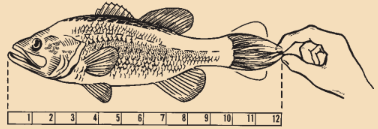
- MINIMUM LENGTH LIMIT: The shortest length of a fish of a designated species that can be kept.
- MAXIMUM LENGTH LIMIT: The maximum length of a fish of a designated species that can be kept.
Slot Limit: A size limit that prohibits anglers from keeping fish within a designated size group. Unless otherwise specified, all fish are measured from the front of the lower jaw with the mouth closed to the tip of the tail with tail lobes pressed together when laid flat on a rule. All fish not meeting the length limit requirements for a particular water or species must be immediately released into the water where caught.
Fish Stocking
Would you like to know where, when and what the Arkansas Game and Fish Commission is stocking? Call the toll-free Family and Community Fish Stocking Hotline: 413-540-FISH (3474)
For more information on the Family and Community Fishing Program, visit www.agfc.com/familyfishing.
| Stocking locations | City | Catfish (Summer) | Trout (Winter) |
|---|---|---|---|
| Beebe Community Pond | Beebe | ● | ● |
| Sunset Lake Benton | Benton | ● | |
| Lake Bentonville | Bentonville | ● | ● |
| Cabot Community Pond | Cabot | ● | ● |
| Conway Station Park Pond Conway | Conway | ● | ● |
| *Mom’s Lake | Corning | ● | |
| *Mattock’s Park | El Dorado | ● | |
| Mike Freeze England Community Pond | England | ● | |
| Carol Ann Cross Pond | Fort Smith | ● | ● |
| Torraine Lake | Fort Smith | ● | ● |
| Wells Lake | Fort Smith | ● | ● |
| John Benjamin Glenwood Community Pond | Glenwood | ● | ● |
| Matthew Park Pond | Greenbrier | ● | ● |
| *Mike and Janet Huckabee Youth Pond | Hope | ● | ● |
| Entergy Park Pond | Hot Springs | ● | ● |
| Family Park | Hot Springs | ● | ● |
| Paradise Lake | Jacksonville | ● | ● |
| *Craighead Forest Youth Fishing Pond | Jonesboro | ● | ● |
| Arkansas State University Pond | Jonesboro | ● | ● |
| *Lake Village Community Fishing Pond | Lake Village | ● | |
| Boyle Park Pond | Little Rock | ● | ● |
| Boyle Park (Rock Creek) | Little Rock | ● | |
| Conner Park Little Rock | Little Rock | ● | |
| Hindman Park | Little Rock | ● | |
| MacArthur Park | Little Rock | ● | ● |
| Pinnacle Mountain State Park Pond | Little Rock | ● | |
| Western Hills Park Pond | Little Rock | ● | ● |
| Marion Sports Complex | Marion | ● | ● |
| Lake Valencia | Maumelle | ● | ● |
| *Monticello High School Pond | Monticello | ● | |
| Amon’s Lake | Mountain Home | ● | ● |
| Reynolds Park Pond | Paragould | ● | ● |
| Martin Luther King Jr. Park Pond | Pine Bluff | ● | ● |
| Redfield City Park | Redfield | ● | ● |
| *Lake Atalanta | Rogers | ● | |
| Pleasant View Park Pond | Russellville | ● | |
| Willow Beach Park Pond | Scott | ● | |
| Searcy City Lake | Searcy | ● | ● |
| Cherrywood Lake | Sherwood | ● | ● |
| Sherwood Municipal City Pond | Sherwood | ● | ● |
| Murphy Park Pond | Springdale | ● | ● |
| Lake Springdale | Springdale | ● | ● |
| Lake Dieffenbacher Texarkana | Texarkana | ● | ● |
| Van Buren Municipal Park Pond | Van Buren | ● | ● |
| Tilden Rodgers Park Pond | West Memphis | ● | ● |
| White Hall Community Pond | White Hall | ● | ● |
| Wynne Sports Complex Pond | Wynne | ● | ● |
| FCFP locations will begin stocking trout the week before Thanksgiving | |||
Daily limits: catfish – 3, trout – 5, bream – 25, largemouth bass may not be retained and must be released immediately. Open to fishing with handheld rod or pole only.
Individuals 16 and older must have a fishing license. Trout permits are required if any trout are retained. Lakes open to electric
trolling motors only.
*Special Family Fishing Regulations – These waters may be fished only by persons 15 and younger and 65 and older or holders of a disability license. Properly licensed individuals that are 16-64 years old may assist and fish with someone who is a youth or disabled and is actively fishing.
Boating Laws
General Requirements
Registering and insuring: Boats propelled by sail or motor must be registered when operated on public waters.
Arkansas boat owners may register a boat at the office of the county revenue agent in the county where the boat is principally used or in their home county. All personal watercraft and motorboats powered by engines of more than 50 horsepower must show proof of $50,000 liability insurance when registering and it must be carried on board at all times.
Out-of-state boats with valid registrations may be operated for up to 90 days without registering in Arkansas.
Operating a boat in excess of 5 mph in a posted no-wake zone, within 100 feet of a recreation area, dock, pier, raft, float, anchored boat or dam intake or other
obstruction is illegal.
Lights
Boats must be equipped with the described lights to be operated during darkness.
- On state-controlled waters, lights on boats, including those on nonpowered boats, must be sufficient to make the boat’s presence and location known to any other vessel within a reasonable distance.
- On federally controlled waters, nonpowered boats must have a readily accessible light source to be used in sufficient time to prevent a collision. Motorboats operating on federally controlled waters must have a combination red-and-green light on the bow and a white light aft.
Fire Extinguishers
Fire extinguishers are required on inboard boats, open boats with built-in fuel tanks and boats with bilges where flammable gases may accumulate.
Age Requirements
To operate a motorboat powered by an engine of 10 horsepower or more:
A person under 12 years of age must:
- Satisfy the boating education requirement and
- Be under the direct visible and audible supervision of a parent, guardian or person at least 18 years of age.
A person 12 years of age or older must satisfy the boating education requirement if born after 1985.
To operate a personal watercraft:
A person under 12 years of age must have a person at least 21 years of age on board who must:
- Satisfy the boating education requirement if born after 1985 and
- Be in a position to take immediate control of the PWC.
A person 12-15 years of age must have a person at least 18 years of age on board who must:
- Satisfy the boating education requirement if born after 1985, and
- Be in a position to take immediate control of the PWC.
You must be at least 16 years of age to operate a personal watercraft without adult supervision, and if born after 1985, you must have passed boating
education and carry proof of passing while operating a PWC. A person under 16 years of age may not operate any personal watercraft that is not rated to
carry at least two people.
Scuba
A diver’s flag means that scuba divers are in the water nearby. Slow down and use caution. Boats are required to operate at idle speed within 100 feet of a diver’s flag.
Boat Capacity
Loading a vessel beyond its stated safe carrying capacity is illegal.
U.S. Army Corps of Engineers
No vessel may enter within 100 yards downstream of an Army Corps of Engineers dam. Operating a vessel in a manner contrary to signs, markers or buoys placed by the Corps controlling speed, skiing or operation of vessels is prohibited.
Kill Switch
For motorboats equipped by the manufacturer with a lanyard-type engine cutoff switch, the boat operator is required to attach the lanyard to his person, clothing or personal flotation device while the engine is in use. However, this requirement does not apply to anyone operating flat-bottomed boats on the tailwater of a trout fishery.
Boat Plugs
All boat plugs must be removed before leaving the loading area. All aquatic vessel drain plugs must be removed before and during transportation. Fishing
tournament officials may submit a request for written permission to allow for the transport of fish to a weigh station (See Page 3 for Fisheries contact information). Transportation of baitfish is allowed in compliance with other baitfish regulations.
Accidents
The operator of a boat involved in an accident is required to immediately:
- Render assistance to other persons affected by the incident to save them or minimize danger so far as he can without causing serious danger to his own boat, crew and passengers;
- Give his or her name, address and identification of his or her boat in writing to any person injured and to the owner of any property damaged in the incident;
- Notify the Arkansas Game and Fish Commission or the local sheriff’s office so an officer can investigate the accident. To report a boating accident, call 800-482-9262 (toll-free). Accidents involving death, injury or property damage in excess of $2,000 must be reported.
Drinking and Boating
A boat operator with a blood alcohol content of .08 percent or greater is considered intoxicated and the boat operator is subject to arrest.
Mandatory Boating Education
Anyone born after 1985 and of legal age to operate a motorboat must have successfully completed an approved Arkansas Game and Fish Commission
Boating Education Course and carry proof of completion while operating any motorboat on Arkansas waters.
A motorboat is defined as any vessel operated upon water propelled by sail or machinery, whether or not the machinery is the principal source of propulsion.
The Boating Education Course is designed to teach the fundamentals of safe and responsible boating and is written on a sixth-grade reading level. The Commission offers the following options for taking the Boating Education Course:
- The classroom course is a minimum six hours of instruction including the examination. This option is free.
- The internet course is available online 24 hours a day, 7 days a week. Students study the material online and must take and pass the online examination. There will be a minimum fee to take the online course.
After successful completion of one of these options, the student will be mailed a Boating Education Card.
Class Schedules: Information about boating education classroom, online or home study courses can be obtained by contacting the Arkansas Game and Fish
Commission at 501-223-6377 (Little Rock) or 877-493-6424 (toll-free). Information and class schedules are available online at www.agfc.com.
Canoes, Kayaks and Inner Tubes
Glass Containers Are Prohibited
Except for containers for substances prescribed by a licensed physician, no person shall possess or use glass containers on Arkansas waters within a vessel easily susceptible to swamping, tipping or rolling. For purposes of this act, “vessel” shall not include a houseboat, party barge, jon boat, runabout, ski boat, bass boat or similar craft.
Fasten Cooler Lids
All coolers, iceboxes or containers for foodstuffs and beverages must be sealed or locked to prevent their contents from spilling into the water while on board a canoe, kayak, inner tube or other vessel easily susceptible to swamping, tipping or rolling while on Arkansas waters.
Attach and Use a Litter Container
Canoes, kayaks, inner tubes and other vessels easily susceptible to swamping, tipping or rolling that are transporting foodstuffs or beverages on Arkansas waters must have a litter container that is capable of being securely closed. All litter must be contained in this container until the litter may be safely and lawfully disposed.
Use a Floating Holder for Beverages
When onboard a canoe, kayak, inner tube or other vessel easily susceptible to swamping, tipping or rolling, any beverage not contained in a sealed or locked container or litter bag must be attached to or held within a floating holder that prevents them from sinking beneath the water’s surface.
Personal Flotation Devices
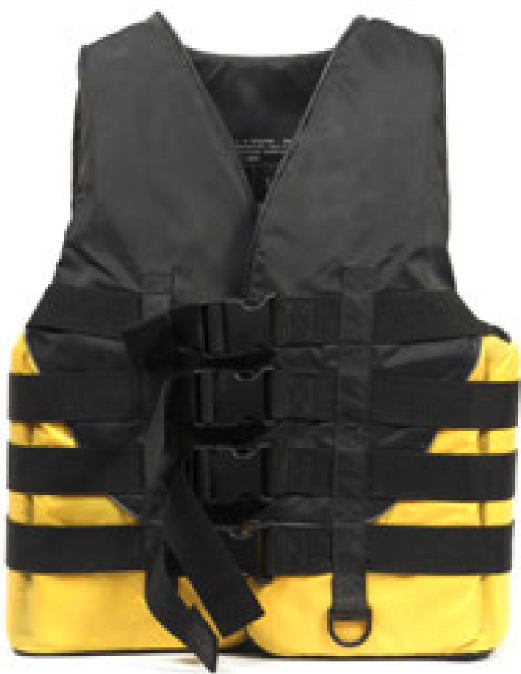
Boats under 16 feet long, canoes and kayaks must have one United States Coast Guard-approved wearable PFD for each person used according to its approved conditions on board.
Boats 16 feet or longer must have one USCG- approved wearable PFD for each person used according to its approved conditions and one USCG- approved throwable PFD on board.
Children under 13 must wear a well-fitting PFD at all times while aboard a boat. The only exceptions are when they are within the enclosed area of a houseboat, cruiser or within the railings of a party barge while the boat is not under way.
Personal watercraft (Jet-Skis, Seadoos, etc.) occupants are required to wear PFDs. Water skiers must wear a USCG-approved wearable PFD used according to its approved conditions.
Water skiing is not allowed from one-half hour after sunset to one-half hour before sunrise. Boats towing water skiers must have, in addition to the driver, an observer at least 12 years old or a wide-angle convex marine mirror to observe the person being towed. Mirrors do not apply when towing persons on
personal watercraft.
PFD Types
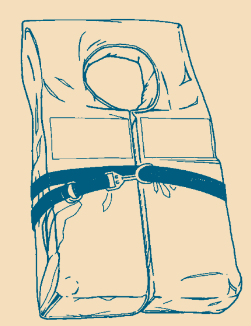
An offshore life jacket provides the most buoyancy. It is effective for all waters, especially open, rough or remote waters where rescue may be delayed. It is designed to turn most unconscious wearers in the water to a face-up position. This PFD comes in two sizes. The adult size provides at least 22 pounds buoyancy; the child size, 11 pounds.
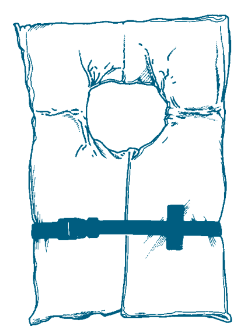
A near-shore buoyant vest is intended for calm, inland water or where there is a good chance of quick rescue. This PFD will turn some unconscious wearers to a face-up position in the water but not as effectively as an offshore life jacket. An adult-size device provides at least 151⁄2 pounds buoyancy, a child size provides
11 pounds. Infant sizes provide at least 7 pounds buoyancy.
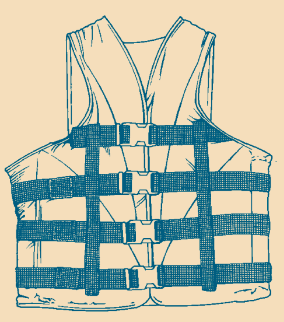
A flotation aid is intended for calm, inland water where there is a good chance of quick rescue. It is designed so conscious wearers can place themselves in a face-up position in the water. The wearer may have to tilt his head back to avoid turning facedown in the water. Examples include foam jackets, float coats, fishing vests and vests designed with features suitable for various water sports.

A throwable device is intended for calm, inland water with heavy boat traffic where help is always present. It is designed to be thrown to a person in the water and grasped and held by the user until rescued. It is not designed to be worn. Examples include buoyant cushions, ring buoys and horseshoe buoys.

A special-use device is intended for specific activities and may be carried instead of another PFD only if used according to the approval condition on the label. Some special-use devices provide significant hypothermia protection. Varieties include deck suits, work vests, board sailing vests and inflatable PFDs.
